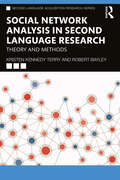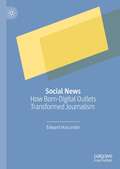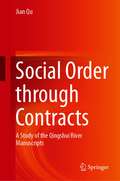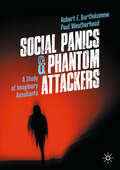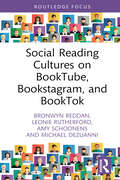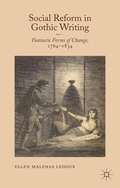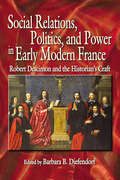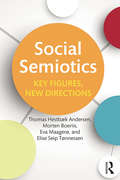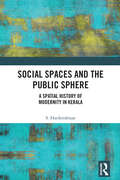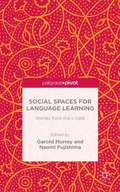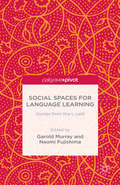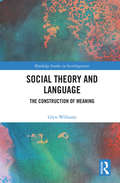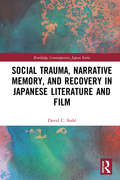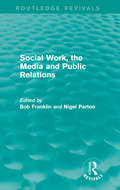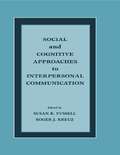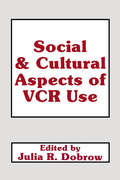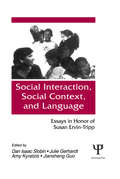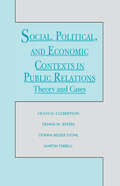- Table View
- List View
Social Network Analysis in Second Language Research: Theory and Methods (ISSN)
by Robert Bayley Kristen Kennedy TerryThis text is the first holistic research overview and practical methodological guide for social network analysis in second language acquisition, examining how to study learner social networks and how to use network data to predict language learner behavior and identity.Authors Kristen Kennedy Terry and Robert Bayley lay out the history of social network analysis in sociolinguistics, discuss the state of the art in empirical findings in applications to language acquisition, offer how-to guidance and best practices for planning, conducting, and understanding this research, and authoritatively set the agenda for future work.With a variety of helpful features like case studies, suggested research projects, discussion questions, and recommended further reading, this book will be an invaluable resource to students and researchers of second language acquisition, sociolinguistics, education, and beyond.
Social Networking Approach to Japanese Language Teaching: The Intersection of Language and Culture in the Digital Age
by Yasu-Hiko TohsakuSocial Networking Approach to Japanese Language Teaching is a timely guide for Japanese language teachers and anyone interested in language pedagogy. The book outlines an innovative approach to language instruction which goes beyond the communicative approach and encourages a global view of language education and curriculum development through the use of social networking. It showcases diverse examples of how social networking can be harnessed and incorporated into everyday language classes to increase learners’ curiosity and engagement in real cultural and global interactions. While the focus is on Japanese language teaching, the concepts explored can be applied to other languages and teaching contexts. This book will benefit teachers of any language as well as linguists interested in language pedagogy.
Social News: How Born-Digital Outlets Transformed Journalism
by Edward HurcombeThis book is the first to define and describe ‘social news’, a new kind of journalism emerging in response to social media. Drawing on the author’s extensive research into news and social media platforms, Social News critically examines the rise of well-known outlets such as BuzzFeed and Mic in the US, and Junkee and Pedestrian in Australia. Hurcombe argues that these outlets became successful by strategically engaging with social media, producing sociable content personalised for millennials. Such outlets have been criticised for violating the rules of ‘quality’ journalism. However, this book shows how social news has provided a platform for marginalised voices and has been able to engage readers neglected by legacy news. While social media is frequently seen as a threat to the news industry, Social News shows that digital platforms have been driving new forms of journalism: ones that challenge our understanding of what journalism is, can be, and should be.
Social Order through Contracts: A Study of the Qingshui River Manuscripts
by Jian QuThis book is the first Western-language monograph on the study of the Qingshui River manuscripts. By examining over 3,000 contracts and other manuscripts, this book offers constructive insights into the long-standing question of how and why a society in late imperial China could maintain a well-functioning social system with few laws but many contracts, i.e., Hobbesian “words without sword.” Three interrelated questions, what contracts were, how and why they worked, are explained successively. Thus, this book presents a non-stereotypical “contract society” in southwest China, arguing that the social order which provides predictability and regularity for economic prosperity could be formed and maintained through contracts even under the condition of relatively weak influence of governmental and legal authorities.This book benefits readers who are interested in law, society, and history. While presenting the socio-legal landscape of a frontier area in late imperial China for historians, this book provides a novel and empirical interpretation of the supposedly well-known contract device for legal researchers, thereby proposing materials for an integrated theoretical explanatory framework of contracts in general. By employing the innovative theory of blockchain in its key argumentation, the book offers a creative interpretation of historical and social phenomena.
Social Panics & Phantom Attackers: A Study of Imaginary Assailants
by Robert E. Bartholomew Paul WeatherheadThis book provides an accessible overview of one particular type of social panic: that of the phantom attacker. Such panics are characterised by outbreaks of sensational claims of attacks by mysterious figures that seem to emerge from nowhere, attack their innocent human and animal victims, only to vanish without a trace. Taking the recent wave of needle-spiking reports in Europe as a starting point, this book does more than just catalogue such outbreaks historically and geographically. It also ties the phenomenon of phantom assailants to the moral panics literature. Meticulously investigating archival sources, the authors examine the social construction of social panics and unearth the parallels between contemporary episodes and historical antecedents in Europe, North America, Asia and Africa. Focusing on the sociohistorical and -cultural context, they uncover the role of mass media in creating and perpetuating these panics, which respond to anxieties pervading societies at particular points in history. Written in a lively style, this book is not only of interest for scholars and students of sociology, criminology, social psychology, media studies and history but also appeals to a lay audience interested in urban legends and true crime.
Social Practices as Biological Niche Construction
by Joseph RouseA broad, synthetic philosophy of nature focused on human sociality. In this book, Joseph Rouse takes his innovative work to the next level by articulating an integrated philosophy of society as part of nature. He shows how and why we ought to unite our biological conception of human beings as animals with our sociocultural and psychological conceptions of human beings as persons and acculturated agents. Rouse’s philosophy engages with biological understandings of human bodies and their environments as well as the diverse practices and institutions through which people live and engage with one another. Familiar conceptual separations of natural, social, and mental “worlds” did not arise by happenstance, he argues, but often for principled reasons that have left those divisions deeply entrenched in contemporary intellectual life. Those reasons are eroding in light of new developments across the disciplines, but that erosion has not been sufficient to produce more adequately integrated conceptual alternatives until now. Social Practices and Biological Niche Construction shows how the characteristic plasticity, plurality, and critical contestation of human ways of life can best be understood as evolved and evolving relations among human organisms and their distinctive biological environments. It also highlights the constitutive interdependence of those ways of life with many other organisms, from microbial populations to certain plants and animals, and explores the consequences of this in-depth, noting, for instance, how the integration of the natural and social also provides new insights on central issues in social theory, such as the body, language, normativity, and power.
Social Reading Cultures on BookTube, Bookstagram, and BookTok
by Michael Dezuanni Bronwyn Reddan Leonie Rutherford Amy SchoonensThis book examines the reading cultures developed by communities of readers and book lovers on BookTube, Bookstagram, and BookTok as an increasingly important influence on contemporary book and literary culture. It explores how the affordances of social media platforms invite readers to participate in social reading communities and engage in creative and curatorial practices that express their identity as readers and book lovers.The interdisciplinary team of authors argue that by creating new opportunities for readers to engage in social reading practices, bookish social media has elevated the agency and visibility of readers and book consumers within literary culture. It has also reshaped the cultural and economic dynamics of book recommendations by creating a space in which different actors are able to form an identity as mediators of reading culture.Concise and accessible, this introduction to an increasingly central set of literary practices is essential reading for students and scholars of literature, sociology, media, and cultural studies, as well as teachers and professionals in the book and library industries.
Social Reform in Gothic Writing
by Ellen Malenas LedouxSocial Reform in Gothic Writing provides a transatlantic view of the politically transformative power that Gothic texts effected during the Revolutionary era (1764-1834) through providing fresh readings of canonical and non-canonical writing in a wide variety of genres.
Social Relations, Politics, and Power in Early Modern France: Robert Descimon and the Historian’s Craft (Early Modern Studies #19)
by Barbara B. DiefendorfThe study of history is a fundamentally sociable practice, with the exchange of ideas taking place in writing, over the seminar table, and often in informal discussions over food. These essays grew out of a web of sociability centered around French historian Robert Descimon, and focus on the nexus of social relations, politics, and power in France as it moved from the age of religious wars into the age of absolutism. Using a wide variety of historical approaches and methods, these essays offer new insights into the evolving role of early modern elites and the social, familial, and cultural influences that shaped their values and priorities.
Social Relations, Politics, and Power in Early Modern France: Robert Descimon and the Historian’s Craft (Early Modern Studies)
by Barbara B. DiefendorfThe study of history is a fundamentally sociable practice, with the exchange of ideas taking place in writing, over the seminar table, and often in informal discussions over food. These essays grew out of a web of sociability centered around French historian Robert Descimon, and focus on the nexus of social relations, politics, and power in France as it moved from the age of religious wars into the age of absolutism. Using a wide variety of historical approaches and methods, these essays offer new insights into the evolving role of early modern elites and the social, familial, and cultural influences that shaped their values and priorities.
Social Semiotics: Key Figures, New Directions (Routledge Studies In Multimodality Ser.)
by Thomas Hestbaek Andersen Morten Boeriis Eva Maagerø Elise Seip TonnessenM.A.K Halliday’s work has been hugely influential in linguistics and beyond since the 1960s. This is a collection of interviews with key figures in the generation of social semioticians who have taken Halliday’s concept of social semiotics and developed it further in various directions, making their own original contributions to theory and practice. This book highlights their main lines of thought and considers how they relate to both the original concept of social semiotics and to each other. Key themes include: Linguistic studies, multilinguality and evolution of language; Text, discourse and classroom studies; Digital texts, computer communication and science teaching; Multimodal text- and discourse analysis; Education and literacy; Media work and visual and audio modes; Critical Discourse Analysis. Featuring interviews with leading figures from linguistics, education and communication studies, a framing introduction and concluding chapter summing up commonalities and differences, connections and conflicts and key themes, this is essential reading for any scholar or student working in the area of social semiotics and systemic functional linguistics. Additional video resources are available on the Routledge website. Featuring: Christian M.I.M. Matthiessen, Theo Van Leeuwen, James R. Martin, Jay Lemke, Gunther Kress
Social Spaces and the Public Sphere: A Spatial-history of Modernity in Kerala
by S. HarikrishnanWhat can social spaces tell us about social relations in society? How do everyday social spaces like teashops, reading rooms, and libraries reify—or subvert—dominant social structures like caste and gender? These are the questions that this book explores through a study of modern Kerala. Using archival material, discourse analysis, participant observation, and personal interviews, this book traces the transformation of public spaces through the nineteenth and twentieth centuries. The volume focuses on how "modernity" has also been a struggle for access to public spaces, and non-institutional spaces like teashops, markets, public roads, temple grounds, reading rooms, and libraries have all been crucial to how political culture was shaped, and how dominant hegemonies—caste, class, or capital—have been challenged. It suggests that the secular public sphere that emerged in the last century in Kerala was a result of the constant negotiations between conflicting ideas which were put to test in these social spaces. At a time when digital spaces are fast replacing physical ones, this book is a timely reminder of the struggles that led to the emergence of secular public spaces in Kerala. It contributes to similar studies on public space that have emerged from other parts of the world over the last decades. A major contribution to understanding modern India, this book will be of interest to scholars and researchers of social history, political science, political sociology, gender studies, linguistics, and South Asian studies.
Social Spaces for Language Learning: Stories from the L-café
by Garold Murray Naomi FujishimaSocial Spaces for Language Learning.
Social Spaces for Language Learning: Stories from the L-café
by Garold MurraySocial spaces for language learning, places where learners can come together in order to learn with and from each other, have an important role to play in foreign language acquisition and L2 identity development. In this book, sixteen students, teachers and administrators tell how they experience the L-café, a social language learning space located on the campus of a Japanese university. As part of a narrative inquiry, their unabridged stories are framed by background information on the study and an in-depth analysis informed by theories of space and place, and complex dynamic systems. Addressing practical as well as theoretical concerns, this book provides advice for language professionals developing and managing social language learning spaces, pedagogical insights for teachers exploring their role in out-of-class learning, and direction for researchers examining the various facets of language learning beyond the classroom.
Social Texts and Context: Literature and Social Psychology (Routledge Revivals)
by Jonathan Potter Margaret Wetherell Peter StringerFirst published in 1984, Social Texts and Context illustrates the ways in which familiar psychological concepts – femininity, the environment, groups, the self – are constructed in discourse. Novels by Thomas Hardy, Barbara Cartland, Doris Lessing, C. P. Snow, Charles Dickens and Robert Musil are examined, and the theoretical approaches of Roland Barthes, Rom Harre, Jonathan Culler, Henri Tajfel, Irving Janis and Paul Willis are discussed. Development in literary theory – such as semiology and deconstruction and in theories of social action – such as ethogenics and discourse analysis – make it difficult to treat literary and psychological texts as a neutral medium of communication. Instead, texts should be seen in terms of their fundamental constructive role in the organization of social life. As the authors demonstrate, contemporary life in both its personal and professional spheres is hedged around by discourse, conversations, newspaper articles, novels, scientific reports. This book will be of interest to students of literature and psychology.
Social Theory and Language: The Construction of Meaning (Routledge Studies in Sociolinguistics)
by Glyn WilliamsThis volume offers a comprehensive treatment of the historical developments underpinning our present understandings of the relationship between language and the social by integrating the study of language with key strands of sociological theory.// The book posits that theory conditions how objects are constructed and in turn the meanings allocated to them and explores the implications for the relationship between language and the social. The volume traces this relationship from its foundations in the work of Enlightenment philosophers, in which sociology and linguistics emerged as coherent disciplines. Taking this work as a point of departure, the book examines the unfolding of the interplay between language and the social across developments in sociological theory in subsequent eras, encompassing such strands as Marxism, functionalism, interactionism, anti-foundationalism, poststructuralism, critical theory, and critical realism. A final chapter turns its eye toward contemporary sociolinguistics and its treatment of different sociological perspectives and future directions for its continued development. // Reflecting on trajectories in sociological theory toward informing our understanding of the relationship between language and the social today, this book will be key reading for students and scholars in sociolinguistics, philosophy of language, and those working in sociology and geography with an interest in language issues.
Social Trauma, Narrative Memory, and Recovery in Japanese Literature and Film (Routledge Contemporary Japan Series)
by David C. StahlThis book provides a comprehensive analysis of major works in Japanese literature and film through the interpretive lens of trauma and PTSD studies. Focusing critical attention on the psychodynamics and enduring psychosocial aftereffects of social trauma, it also evaluates the themes of dissociation, failed mourning, and psychological defence fantasies. Building on earlier studies, this book emphasizes the role of protagonists in managing to effect partial recovery by composing memoirs in which they transform dissociated traumatic memory into articulate, narrative memory or bring about advanced recovery by pioneering alternative means of orally communicating, working through, and overcoming debilitating personal histories of traumatization and victimization. In so doing, Stahl also demonstrates that what holds true on the individual and microcosmic level, also does so on the collective and macrocosmic level. This new critical approach sheds important new light on canonical Japanese novels and films and enables recognition and appreciation of integral psychosocial aspects of these traumatic narratives. As such, the book will be of huge interest to students and scholars of Japanese film and literature, as well as those of trauma studies.
Social Variation and the Latin Language
by J. N. AdamsLanguages show variations according to the social class of speakers and Latin was no exception, as readers of Petronius are aware. The Romance languages have traditionally been regarded as developing out of a 'language of the common people' (Vulgar Latin), but studies of modern languages demonstrate that linguistic change does not merely come, in the social sense, 'from below'. There is change from above, as prestige usages work their way down the social scale, and change may also occur across the social classes. This book is a history of many of the developments undergone by the Latin language as it changed into Romance, demonstrating the varying social levels at which change was initiated. About thirty topics are dealt with, many of them more systematically than ever before. Discussions often start in the early Republic with Plautus, and the book is as much about the literary language as about informal varieties.
Social Work, the Media and Public Relations (Routledge Revivals)
by Bob Franklin Nigel PartonOver the past few decades, relationships between social workers and the media have become increasingly challenging. Social workers feel aggrieved by media reporting of their profession and believe that journalists lack sufficient knowledge and experience of the social services to report matters adequately and sensitively, whilst some journalists have urged social workers to adopt a more proactive public relations strategy. This book, first published in 1991, analyses the causes and consequences of the negative portrayal of social work within the media and considers various ways in which this image might be improved. The authors consider a variety of developments during the 1990s designed to redress imbalances in media reporting and present a more accurate picture of social workers and the people with whom they work. This title remains very relevant in light of the high profile cases related to the social service that continue to feature in the British press, and will be of particular value to students and researchers with an interest in the relationship between the media and social policy.
Social and Cognitive Approaches to Interpersonal Communication
by Roger J. Kreuz Susan R. FussellHistorically, the social aspects of language use have been considered the domain of social psychology, while the underlying psycholinguistic mechanisms have been the purview of cognitive psychology. Recently, it has become increasingly clear that these two dimensions are highly interrelated: cognitive mechanisms underlying speech production and comprehension interact with social psychological factors, such as beliefs about one's interlocutors and politeness norms, and with the dynamics of the conversation itself, to produce shared meaning. This realization has led to an exciting body of research integrating the social and cognitive dimensions which has greatly increased our understanding of human language use. Each chapter in this volume demonstrates how the theoretical approaches and research methods of social and cognitive psychology can be successfully interwoven to provide insight into one or more fundamental questions about the process of interpersonal communication. The topics under investigation include the nature and role of speaker intentions in the communicative process, the production and comprehension of indirect speech and figurative language, perspective-taking and conversational collaboration, and the relationships between language, cognition, culture, and social interaction. The book will be of interest to all those who study interpersonal language use: social and cognitive psychologists, theoretical and applied linguists, and communication researchers.
Social and Cultural Aspects of Vcr Use (Routledge Communication Series)
by Julie DobrowFirst Published in 1990. Routledge is an imprint of Taylor & Francis, an informa company.
Social and Regional Variation in World Englishes: Local and Global Perspectives (Routledge Studies in Sociolinguistics)
by Paula Rautionaho, Hanna Parviainen, Mark Kaunisto and Arja NurmiThis collection charts the evolution of grammatical variation in Englishes from the Late Middle English to the present, using corpus linguistic tools to address divergence and convergence in local and global perspectives. The book considers both diachronic and synchronic perspectives in grammatical variation across varieties of English across the UK, North America, Europe, Africa, and Asia. The volume reflects on the questions of whether patterns of variation diverge or converge and to what extent catalysts for change are shared in time and space. Chapters look at different factors in grammatical variation at both the macro and micro level, investigating specific linguistic and grammatical features but also at wider phenomena in contact linguistics, social patterns, social networks, and media-based corpora. Chapters progress from the local to the global, all with an eye toward using the latest methodological approaches from corpus linguistics to shed light on the affordances of data-informed methods to study grammatical change and the possibilities for future research. This book will be of interest to students and scholars in sociolinguistics, corpus linguistics, and World Englishes.
Social and Regional Variation in World Englishes: Local and Global Perspectives (Routledge Studies in Sociolinguistics)
by Paula Rautionaho, Hanna Parviainen, Mark Kaunisto and Arja NurmiThis collection charts the evolution of grammatical variation in Englishes from Late Middle English to the present, using corpus linguistic tools to address divergence and convergence in local and global perspectives.The book considers both diachronic and synchronic perspectives in grammatical variation across varieties of English across the UK, North America, Europe, Africa, and Asia. The volume reflects on the questions of whether patterns of variation diverge or converge and to what extent catalysts for change are shared in time and space. Chapters look at different factors in grammatical variation at both the macro and micro level, investigating specific linguistic and grammatical features but also at wider phenomena in contact linguistics, social patterns, social networks, and media-based corpora. Chapters progress from the local to the global, all with an eye towards using the latest methodological approaches from corpus linguistics to shed light on the affordances of data-informed methods to study grammatical change and the possibilities for future research.This book will be of interest to students and scholars in sociolinguistics, corpus linguistics, and World Englishes.
Social interaction, Social Context, and Language: Essays in Honor of Susan Ervin-tripp
by Dan Isaac Slobin Jiansheng Guo Julie Gerhardt Amy KyratzisThis collection of essays is a representative sample of the current research and researchers in the fields of language and social interactions and social context. The opening chapter, entitled "Context in Language," is written by Susan Ervin-Tripp, whose diverse and innovative research inspired the editors to dedicate this book to her honor. Ervin-Tripp is known for her work in the fields of linguistics, psychology, child development, sociology, anthropology, rhetoric, and women's studies. She has played a central role in the definition and establishment of psycholinguistics, child language development, and sociolinguistics, and has been an innovator in terms of approaches and methods of study. This book covers a wide range of research interests in the field, from linguistically oriented approaches to social and ethnography oriented approaches. The issue of the relationships between forms and structures of language and social interactions is examined in studies of both adult and child speech. It is a useful anthology for graduate students studying language and social interaction, as well as for researchers in this field.
Social, Political, and Economic Contexts in Public Relations: Theory and Cases (Routledge Communication Series)
by Hugh M. Culbertson Martin Terrell Dennis W. Jeffers Donna Besser StoneTwo commissions within the Public Relations Society of America have recently defined courses in case-study analysis, research methods, and behavioral-science theory as central to an acceptable public relations curriculum. To date, these three "streams" within PR education have run independently of each other. The authors produced this volume because they believe that there is a growing demand for an integrative "applied theory" approach to the study of public relations cases. The need for PR professionals to study the social, political, and economic contexts of public relations carefully had been apparent for some time as issues management and environment scanning emerged as focal points of modern public relations. Yet there was no systematic framework for such study. This volume, however, with its strong foundation in theory, provides just that framework and is highly suitable for graduate-level courses in public relations.
